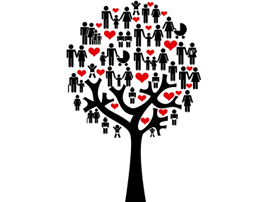Below you will find what I have identified to be the5 most common hereditary heart disordersthat I see in my practice. I will also go into how you may even be able to change your genes!

- Hypercholesterolemia (Inherited High Cholesterol)
- Familial Dilated Cardiomyopathy
- Familial Atrial Fibrillation
- Familial Heart Valve Disease
- Long QT Syndrome (LQTS)
For most people, cholesterol levels are influenced by what they eat or how old they are. But for 1 in 500 people, genetics is a determining factor. These people have a familial hypercholesterolemia, a hereditary condition that causes abnormally high levels of LDL (“bad”) cholesterol. People with familial hypercholesterolemia have a genetic mutation on chromosome number 19, which prevents their bodies from clearing LDL cholesterol. Total LDL cholesterol for a person who inherited one genetic mutation (known as a heterozygote) would typically be 300 to 400 mg/dL. In the far more rare instance that a person inherits the gene mutation from both parents (homozygote), their total cholesterol could reach 1,000 mg/dL. Most people with this disorder can be successfully treated with statins.
Some 750,000 people in the U.S. have dilated cardiomyopathy, a condition in which the heart can’t pump enough blood because of an enlarged and weakened left ventricle. This can lead to heart failure. It’s estimated that half of those cases are hereditary. Other causes include aging, damage from heart attack, and alcohol abuse. More than 30 genes are linked to this condition. However, dilated cardiomyopathy can also occur as part of syndromes that affect other organs and tissues in the body. In addition, there are other forms of cardiomyopathy that may be linked to inheritance. Like cardiomyopathies that are not inherited, this form of the disease is treated with cardiac medications.
Atrial fibrillationis the most common heartbeat abnormality, affecting more than 3 million Americans. It’s estimated that up to 30 percent of them may have inherited the disorder. Familial atrial fibrillation is believed to be inherited in an autosomal dominant pattern, although in rare cases it may be associated with more than one gene. Inherited or not, atrial fibrillation increases the risk of stroke, as well as sudden cardiac death, so its diagnosis and management are very important.
The heart has four cardiac valves that work together to make sure blood flows in a proper forward fashion. These are the mitral, tricuspid, pulmonary, and aortic valves. With aging, these valves can become stiffened or leaky, which results in malfunctioning. But valve disease can also be inherited.
Long QT Syndrome (LQTS)is a rare malfunction in the way the heart cells recharge after producing electricity. It can lead to a dangerous heartbeat irregularity that can cause fainting or even sudden death.Some people show no symptoms and are only diagnosed when they get an ECG for other reasons. Others may be diagnosed when family members are found to have genetic LQTS. Symptoms can include palpitations, seizure-like activity caused by lack of blood flow to the brain, dizziness or fainting, and sudden cardiac arrest. There are people whose family members have LQTS and who share the genetic mutation, but never have symptoms themselves.
Changing Your Genes Through Strict Diet And Exercise
It used to be thought that people couldn’t change their genes. You know the old saying: “You can’t choose your parents.” But we’ve learned that the human genome is, in fact, dynamic and ever-changing, with genes constantly turning on or off, depending on what biochemical signals they receive from the body.
This field of study, called Epigenetics, concerns how outside forces affect DNA through a process known as methylation. Although still in its infancy, epigenetics is very intriguing.
For instance, Swedish scientists recruited 23 young, healthy volunteers and had them exercise only one leg on a bicycle for three months. Not surprisingly, the exercised leg grew stronger.
What surprised the researchers was that they discovered more than 5,000 genes on the muscle cells from the exercised leg showed changes in their methylation pattern.
Scientists are finding that foods can cause epigenetic changes as well. For example, broccoli, soy, green tea, and curcumin have all been found to cause genetic changes.
These discoveries make us realize that eating healthy can actually improve the body’s genetic responses.
I’m not surprised. I’ve seen patients with familial hypercholesterolemia control their cholesterol numbers with strict diet and exercise. Through their lifestyles, they were able to avoid “turning on” these genetic changes.
